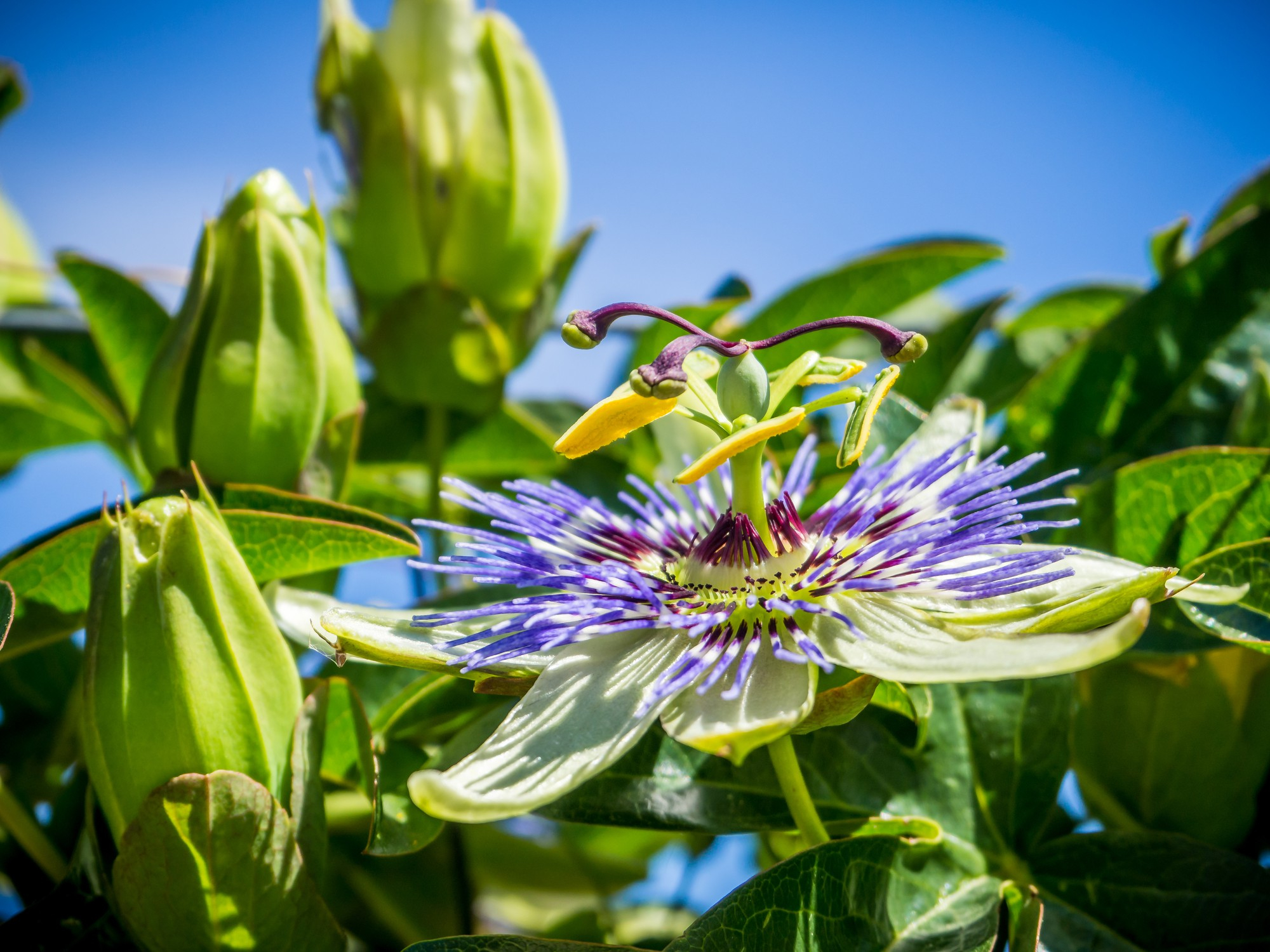How to Grow Passion Flower: A Complete Guide to Passion Fruit Flowers
Passion flowers, with their stunning blooms and delicious fruits, are a delightful addition to any garden. Their vibrant colors, unique structures, and the sweet allure of the passion fruit make them a favorite among gardeners and horticultural enthusiasts alike. This guide will provide you with everything you need to know to grow these captivating plants successfully, from understanding the different varieties to caring for your passion flower plants.
What is Passion Flower and Its Varieties?
The passion flower belongs to the genus Passiflora, which encompasses over 500 species, most of which are native to tropical and subtropical regions. These plants are known for their intricate flowers that often have a unique structure, including a corona made up of filaments, and a star-shaped arrangement of petals and sepals. Passion flowers are not only prized for their beauty but also for their fruits, commonly referred to as passion fruits. The fruits of various species, such as Passiflora edulis and Passiflora caerulea, are utilized in culinary applications, ranging from fresh eating to making juices, desserts, and even cocktails.
Differences Between Passiflora Caerulea and Passiflora Edulis
Among the most popular species are Passiflora caerulea, commonly known as blue passion flower, and Passiflora edulis, known for its sweet, edible fruit. While both species share beautiful blooms, they exhibit distinct characteristics. Passiflora caerulea is a hardy type that can tolerate cooler climates, making it suitable for outdoor cultivation in many regions. It produces large, striking flowers but its fruit is often less palatable than that of Passiflora edulis, which thrives in warmer conditions and yields delicious, aromatic fruit. The fruit of Passiflora edulis can be purple or yellow, with the yellow passion fruit being particularly popular for its sweetness.
Common Varieties of Passion Flower
In addition to the aforementioned species, there are several other varieties of passion flower that gardeners may find appealing. For instance, Passiflora alata, or the winged-stem passion flower, is known for its fragrant flowers and sweet fruits. Another notable variety is Passiflora mollissima, commonly called giant granadilla, which produces large, edible fruits that are highly sought after in tropical regions. When you decide to buy passion flower plants, consider these options based on your climate and personal preferences. Each variety offers unique flavors and visual appeal, ensuring that you will find a passion flower that suits your gardening needs.
How to Grow Passion Flowers Successfully?
To grow passion flowers successfully, it’s essential to create the ideal growing conditions. These vines thrive in warm environments, ideally in temperatures ranging from 60°F to 85°F (15°C to 29°C). For those living in cooler climates, growing passion flowers in a conservatory or greenhouse can help maintain the necessary warmth and humidity levels. Passion flowers prefer full sun, so positioning them in a location that receives at least six hours of direct sunlight each day is crucial for promoting vigorous growth and abundant blooming.
Best Soil Types for Passion Fruit Plants
When it comes to soil for passion fruit plants, well-draining, fertile soil is key. A mixture of loamy soil with added organic matter, such as compost, provides the nutrients and drainage that these plants require. Passion flowers thrive in slightly acidic to neutral pH levels, ideally between 6.0 and 7.0. If you are starting your plants in pots, consider using 2-litre pots filled with this rich soil mixture to ensure healthy root development. If you are growing them outside, amend your garden soil accordingly to achieve the best results.
Watering and Fertilizing Techniques for Optimal Growth
Watering is another critical aspect of growing passion flowers. These plants require consistent moisture but do not tolerate waterlogged conditions. It’s best to water them deeply but infrequently, allowing the top inch of soil to dry out between waterings. During the growing season, which typically spans from spring to early autumn, fertilizing with a balanced fertilizer every four to six weeks will promote vigorous growth and flowering. Look for fertilizers that contain high levels of potassium to encourage fruit development, especially if you are growing varieties like Passiflora edulis.
What is the Morphology of Passion Flower Plants?
The morphology of passion flower plants is equally fascinating as their cultivation. The leaves of passion flowers are typically lobed and can vary in shape depending on the species. They are generally dark green and glossy, providing a lush backdrop for the striking blooms. The leaves also play a vital role in photosynthesis, enabling the plant to convert sunlight into energy, which is essential for growth and fruit production.
The Role of Tendrils in Passion Flower Growth
Tendrils are another unique feature of passion flower plants. These slender, coiling structures help the vine climb and attach itself to support structures, allowing the plant to reach towards sunlight. The tendrils are crucial for the growth of passion flowers, as they enable the plant to expand its reach and maximize its exposure to light, which is vital for blooming and fruiting.
Flowering and Fruit Development in Passion Fruit
The flowering process of passion flowers is a sight to behold. The blooms typically feature a central arrangement of stamens and a stigma, surrounded by the beautiful corona. Pollination can occur through various means, including insects like bees, which are attracted to the vibrant colors and fragrant aromas. Once pollination occurs, passion flowers produce numerous seeds within the fruit, which develop over time into the juicy passion fruit we love. The transition from flower to fruit can take several months, and proper care during this time is essential to ensure a bountiful harvest.
How to Care for Your Passion Flower Plants?
Caring for passion flower plants involves vigilance against pests and diseases. Common pests include aphids, spider mites, and whiteflies, which can adversely affect the health of the plants. Utilizing organic insecticides or introducing beneficial insects can help manage these pests. Additionally, keeping the foliage dry and well-ventilated can prevent fungal diseases, which may arise in humid environments. Regular inspection of your plants will enable you to catch any issues early, ensuring your passion flowers remain healthy and vibrant.
Pruning Techniques for Healthy Passion Fruit Shrubs
Pruning is another essential aspect of maintaining passion flower plants. Pruning helps to shape the plant, remove dead or diseased growth, and encourage bushier growth. It’s best to prune after the flowering period has ended, which allows the plant to focus its energy on new growth. When pruning, focus on removing any overly long vines and thinning out crowded areas to improve air circulation, which is crucial for health and growth.
Seasonal Care Tips for Passion Flower Plants
Seasonal care is vital for the success of your passion flower plants. During the warmer months, ensure they receive adequate water and nutrients, while in the cooler months, protect them from frost by moving pots indoors or covering outdoor plants. Be mindful of their specific needs throughout the seasons to promote robust growth and flowering. Additionally, consider using mulch around the base of the plants to retain moisture and regulate soil temperature.
When and How to Harvest Passion Fruit?
Knowing when to harvest passion fruit is crucial for enjoying the best flavor. Generally, passion fruits are ready to be harvested when they are fully colored and slightly wrinkled, indicating that they have reached peak ripeness. For varieties like Passiflora edulis, the fruits will turn dark purple, while the yellow passion fruit will become a vibrant yellow. The wrinkling of the skin is a good indicator that the fruit is sweet and aromatic.
Harvesting Techniques for Passion Fruit
When harvesting passion fruit, it is essential to handle the fruits gently to avoid bruising. Use garden shears or scissors to cut the fruit from the vine, leaving a small portion of the stem attached. This technique helps preserve the fruit’s freshness during storage. If you harvest fruits that are not entirely ripe, they can still be allowed to ripen at room temperature, developing their characteristic flavors and aromas.
Post-Harvest Care for Passion Fruit Flowers
After harvesting your passion fruits, proper post-harvest care is necessary to maintain quality. Store the fruits in a cool, dry place, away from direct sunlight. If you have an abundance of passion fruits, consider freezing or pureeing them for later use in smoothies, desserts, or sauces. Additionally, if you plan to save seeds for propagation, ensure that the seeds are cleaned and dried thoroughly before storage. This care ensures that your passion flowers continue to thrive and produce fruit for seasons to come.

